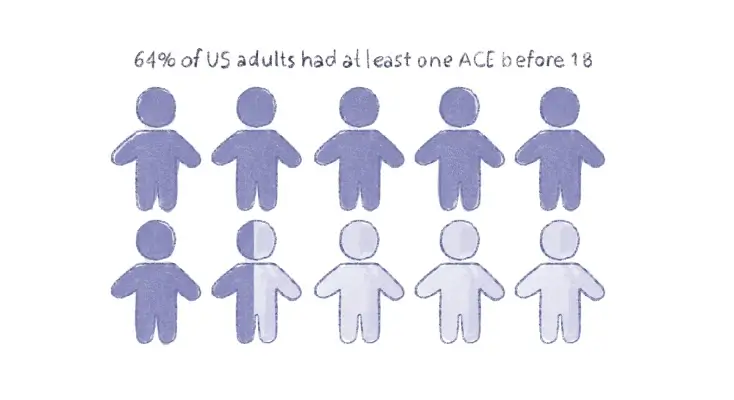Key numbers:
- Childhood trauma is prevalent in the US, with nearly two-thirds of adults reporting having at least one adverse childhood experience (ACE) before their 18th birthday.
- Women tend to have higher ACE scores compared to men, with 15.2% reporting four or more ACEs.
- At least 1 in 7 children has experienced child abuse and/or neglect in the past year, with neglect being the most common form.
- People who face four or more types of ACE as kids are 12 times more likely to experience mental health issues, particularly anxiety, drug abuse, depression, and suicide attempts.
How common is childhood trauma?
This happens a lot nowadays, too. Nearly two-thirds of adults (64%) in the US said they had at least one ACE before their 18th birthday. [1]
About one-seventh of adults (17.3%) said they had endured four or more major adverse childhood experiences (ACEs). [2]

Childhood trauma statistics by gender
According to other childhood trauma statistics, women tend to have higher ACE scores compared to men. Particularly at the higher end of the scale (three or more ACEs).
This suggests that women in this study may experience a greater number or severity of adverse experiences in childhood compared to men.
To illustrate this, according to statistics, a significantly higher percentage of women (15.2%) report having four or more ACEs compared to men (9.2%). [3,4]

Adverse childhood experiences statistics and their prevalence by category
At least 1 in 7 children have experienced child abuse and/or neglect in the past year, and this is likely an underestimate. [5]

Nationally, neglect is the most common form of ACEs. In fact, about 14.8% of children experience emotional neglect, and 9.9% — physical neglect. [4]
Next, abuse is the second most common type. For example, more than 550,000 children are abused in the US each year. In more detail, 17% experience physical abuse, 11% — sexual abuse, and 0.2% — sex trafficking. [6]

Natural disasters cause another type of childhood trauma. Around 5-6% of children are affected by natural disasters, like bushfires, floods, and storms. [7]
Finally, household challenges are also included in important statistics on trauma. 26.9% of children live with ACEs because of substance use by a loved one, 23.3% after parental divorce, and 19.4% after a mental illness of a relative. [4]
ACE score statistics
ACE score is a tally of stressful events a person faces in their early years. Today, in the USA, approximately:
- 42% of people have an ACE score of 0
- 22.9% — 1 ACE
- 12.8% — 2 ACEs
- 8.2% — 3 ACEs
- 5.7% — 4 ACEs
- 7.6% — 5 or more ACEs [8]
Impact of childhood trauma with facts
In the late 1990s, researchers found that having a hard childhood can cause long-term health problems later on. What was most surprising was how common these problems were across all social classes.
Let’s take a look at the most important facts about trauma.
Childhood trauma makes it more likely to develop a mental health or substance use disorder.
The long-term effects of traumatic experience include increased risk of drug abuse, sexually transmitted diseases, delayed brain development, lower educational attainment, limited employment opportunities, and future victimization and violence.
Fact: According to childhood trauma and addiction statistics, people who face four or more types of ACE as kids are much more likely to struggle with things like alcoholism, drug abuse, depression, and suicide attempts—up to 12 times more likely. [9]

Fact: Children who have experienced four or more adverse childhood experiences are 3.7 times more likely to suffer from anxiety in adulthood. On top of that, they are 4.7 times as likely to experience long-lasting depression and 5 times higher risk of ADHD. [10]
Fact: Research highlights the correlation between average ACE scores and people’s income. Respondents making less than $15,000 per year had a significantly higher mean ACE score, while the $50,000+ group had significantly lower ACE scores compared to others. [9]
Fact: 5 out of 10 leading causes of death can be somehow connected to ACEs. [11]
Fact: The same source of statistics on childhood trauma states that an ACE score of 4 or more can triple the risk of having serious problems working.
Fact: Statistics show that people who have been through traumatic events as children are about twice as likely to be overweight in their adult life. [12]

Trauma statistics sources
- Centers for Disease Control and Prevention. “Why Injury and Violence Prevention Matter.” May 2024.
- Centers for Disease Control and Prevention. “About Adverse Childhood Experiences.” May 2024
- National Institute of Health (NIH). “The Effect of Maternal Adverse Childhood Experiences (ACEs) on Substance Use During Pregnancy.” September 2023.
- Centers for Disease Control and Prevention. “About the CDC-Kaiser ACE Study.” September 2020.
- Centers for Disease Control and Prevention. “About Child Abuse and Neglect.” May 2024.
- National Children’s Alliance. “National Statistics on Child Abuse.” August 2024
- Emerging Minds. “Adverse Childhood Experiences (ACEs) and resilience – parent fact sheet.” February 2020
- BMC Public Health. “The frequencies and disparities of adverse childhood experiences in the U.S.” September 2020
- National Institute of Health (NIH). “The Impact of Adverse Childhood Experiences on Health and Development in Young Children.” February 2022
- Valley Children’s Healthcare. “Adverse Childhood Experiences: Why It Is Not So Simple to “Just Get Over It.” May 2023
- Stop Abuse Campaign. “What does your ACE score mean?” September 2020
- European Journal of Public Health. “Adverse Childhood Experiences (ACEs) in Wales and their Impact on Health in the Adult Population.” November 2016
Disclaimer
This article is for general informative and self-discovery purposes only. It should not replace expert guidance from professionals.
Any action you take in response to the information in this article, whether directly or indirectly, is solely your responsibility and is done at your own risk. Breeze content team and its mental health experts disclaim any liability, loss, or risk, personal, professional, or otherwise, which may result from the use and/or application of any content.
Always consult your doctor or other certified health practitioner with any medical questions or concerns
Breeze articles exclusively cite trusted sources, such as academic research institutions and medical associations, including research and studies from PubMed, ResearchGate, or similar databases. Examine our subject-matter editors and editorial process to see how we verify facts and maintain the accuracy, reliability, and trustworthiness of our material.
Was this article helpful?





